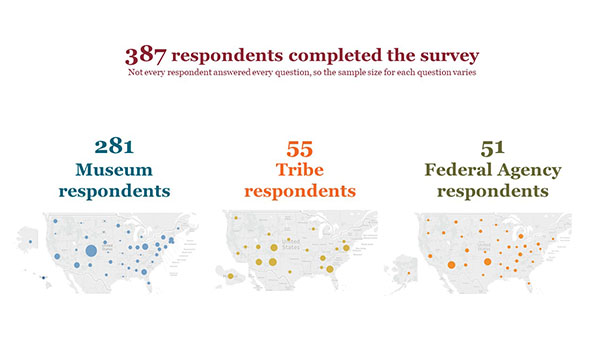NAGPRA Community of Practice Survey Results
Last spring the University of Denver Museum of Anthropology hosted a two-day summit to identify issues affecting NAGPRA implementation in museums and brainstorm ways to impact those issues. In preparation for the summit we conducted a nation-wide survey to collect information on the current state of NAGPRA implementation in museums and identify needs for the future. With responses from NAGPRA practitioners (and non-practitioner museum professionals) we hoped to ensure a broad range of concerns were captured and included for discussion on the summit agenda. Preliminary results were divided into three handouts distributed to participants throughout the two days. In an effort to increase response numbers, the survey remained open until January 2020. These are the final survey results.
I wanted to share my own perspective on a few of the results. I encourage you to develop your own comments and questions and join me at the next NAGPRA Community of Practice monthly call to discuss the results.
387 respondents completed the survey and nearly 75% were museum respondents (pages 1, 9, and 17)
The summit and the larger initiative to create a network of NAGPRA practitioners across the U.S. began with a focus on implementation in museums. The overwhelming majority of responses from museum practitioners reflects that early focus. As this project has progressed, we are working to make the NAGPRA Community of Practice for all practitioners.
Limited staff hours and budget for NAGPRA work (page 3)
One of the goals of the survey was to better understand the obstacles practitioners face implementing NAGPRA. Limited staff hours and budget for NAGPRA work was selected as the top major barrier among all respondents. A reoccurring theme that emerged in additional comments from museum respondents pointed to the fact that institutions and individuals are not prioritizing NAGPRA work.
Many NAGPRA practitioners work alone – 68% of museum respondents reported that their museum had 1-2 staff responsible for NAGPRA. The NAGPRA Community of Practice can help us feel supported and part of a larger group. We can share templates and documents so we don't have to reinvent the wheel. We can collaborate and combine efforts to make the most of limited resources. We can also help each other advocate for prioritizing NAGPRA work at our institutions.
Rights and Responsibilities under NAGPRA (page 5)
When asked if they thought their museum was respecting the rights of Tribes and Native Hawaiian Organizations under NAGPRA, 72% of museum respondents said yes. Two other responses highlight the fact that opinions vary as to what those rights are. Only 50% of museum respondents said their museum was including tribes in identifying consultation goals and defining success and only 49% of respondents said they were bringing decision makers to the table with consulting tribes. I believe both of those things are important elements of respecting Tribes' rights under NAGPRA.
The NAGPRA Community of Practice provides opportunities for practitioners to share how they are implementing NAGPRA in ways that ensure rights under NAGPRA are respected. That is one reason why it is especially important that tribal practitioners are a part of the NAGPRA Community of Practice.
Guidance and Group Discussions (page 27)
When asked what would improve their ability to implement NAGPRA – the two highest responses among all respondents was: guidance from professional organizations on implementation; and group discussions with colleagues doing similar work.
In response to the latter we started a monthly group call for NAGPRA practitioners to connect. We've only done a handful so far but I'm looking forward to seeing how they progress. There is also opportunity for local and regional practitioners to form their own discussion groups.
In terms of guidance from professional organizations, I think this is difficult to do because there are so many diverse opinions on multiple aspects of NAGPRA. However, I hope our continued discussions can help practitioners see how others are approaching compliance activities.
Please take a moment to review the final survey results yourself and join me on April 24th at 11am MT for the NAGPRA Community of Practice monthly call.



